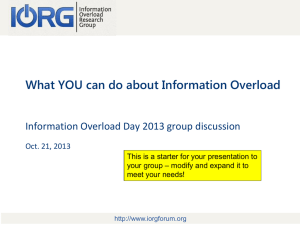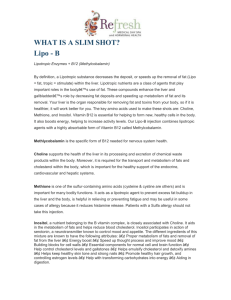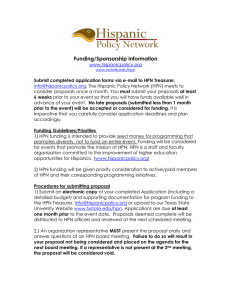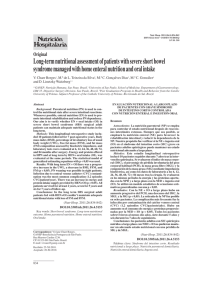Is removal of the fat component from the PN mixture efficient
advertisement
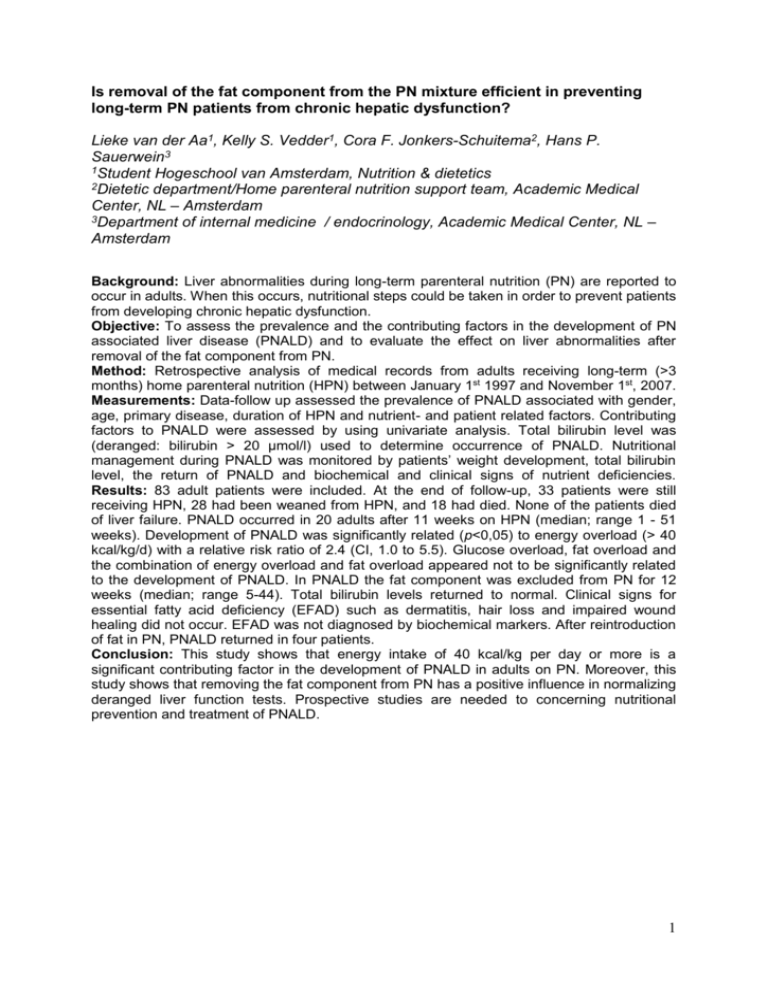
Is removal of the fat component from the PN mixture efficient in preventing long-term PN patients from chronic hepatic dysfunction? Lieke van der Aa1, Kelly S. Vedder1, Cora F. Jonkers-Schuitema2, Hans P. Sauerwein3 1Student Hogeschool van Amsterdam, Nutrition & dietetics 2Dietetic department/Home parenteral nutrition support team, Academic Medical Center, NL – Amsterdam 3Department of internal medicine / endocrinology, Academic Medical Center, NL – Amsterdam Background: Liver abnormalities during long-term parenteral nutrition (PN) are reported to occur in adults. When this occurs, nutritional steps could be taken in order to prevent patients from developing chronic hepatic dysfunction. Objective: To assess the prevalence and the contributing factors in the development of PN associated liver disease (PNALD) and to evaluate the effect on liver abnormalities after removal of the fat component from PN. Method: Retrospective analysis of medical records from adults receiving long-term (>3 months) home parenteral nutrition (HPN) between January 1st 1997 and November 1st, 2007. Measurements: Data-follow up assessed the prevalence of PNALD associated with gender, age, primary disease, duration of HPN and nutrient- and patient related factors. Contributing factors to PNALD were assessed by using univariate analysis. Total bilirubin level was (deranged: bilirubin > 20 µmol/l) used to determine occurrence of PNALD. Nutritional management during PNALD was monitored by patients’ weight development, total bilirubin level, the return of PNALD and biochemical and clinical signs of nutrient deficiencies. Results: 83 adult patients were included. At the end of follow-up, 33 patients were still receiving HPN, 28 had been weaned from HPN, and 18 had died. None of the patients died of liver failure. PNALD occurred in 20 adults after 11 weeks on HPN (median; range 1 - 51 weeks). Development of PNALD was significantly related (p<0,05) to energy overload (> 40 kcal/kg/d) with a relative risk ratio of 2.4 (CI, 1.0 to 5.5). Glucose overload, fat overload and the combination of energy overload and fat overload appeared not to be significantly related to the development of PNALD. In PNALD the fat component was excluded from PN for 12 weeks (median; range 5-44). Total bilirubin levels returned to normal. Clinical signs for essential fatty acid deficiency (EFAD) such as dermatitis, hair loss and impaired wound healing did not occur. EFAD was not diagnosed by biochemical markers. After reintroduction of fat in PN, PNALD returned in four patients. Conclusion: This study shows that energy intake of 40 kcal/kg per day or more is a significant contributing factor in the development of PNALD in adults on PN. Moreover, this study shows that removing the fat component from PN has a positive influence in normalizing deranged liver function tests. Prospective studies are needed to concerning nutritional prevention and treatment of PNALD. 1







